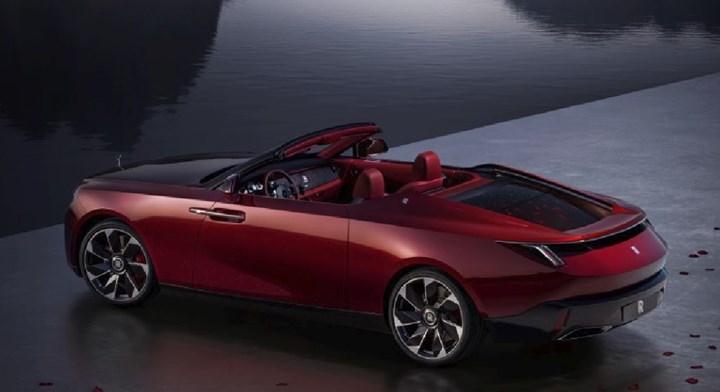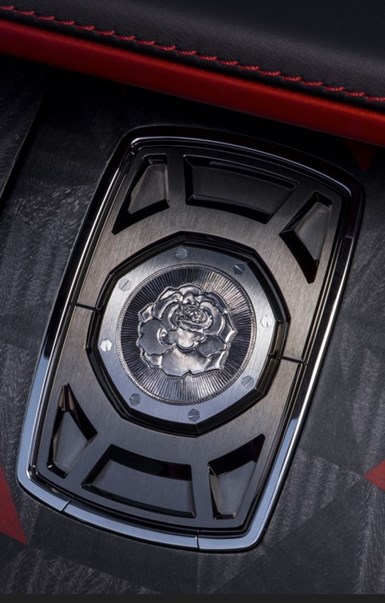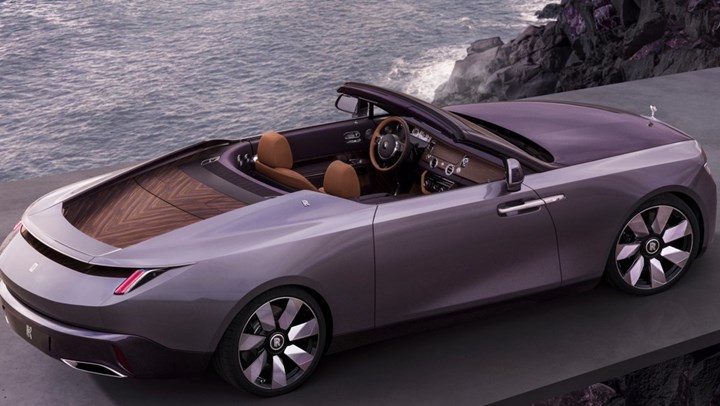A Remarkable Rolls
Alex Innes, head of coachbuild design, Rolls-Royce Motor Cars, describes the specially commissioned La Rose Noire Droptail as “glamour distilled.” The finishes, outside and in, contribute largely to that charm.
“Rolls-Royce La Rose Noire Droptail stands as one of the most progressive expressions of Rolls-Royce Coachbuild ever conceived.-- Anders Warming, design director, Rolls-Royce Motor Cars
There are certainly cars that one can designate as being “over the top” without exaggeration. To describe the Rolls-Royce La Rose Noire Droptail like that would be to understate the case.
Let’s look at the privately commissioned vehicle simply from the standpoint of paint.
- The paint theme is based on the Black Baccara rose. This French flower has petals with a dark pomegranate color. The petals appear nearly black when in the shade. In the light, there is a red pearlescent shimmer revealed on the surface.
- Those two colors are the basis of development for the coatings of La Rose Noire: the dark tone is “Mystery”; the red shade “True Love.”
- True Love is used for the body color. To apply it to the surface, Rolls-Royce paint engineers developed what they’ll only describe as “a completely new paint process.” It required 150 iterations to get there.
- To achieve True Love, there is a base coat applied. Its color “is a closely guarded secret.” (Appropriate for love, one thinks.)
- There are five layers of clear(ish) lacquer applied on the base coat: each layer is blended with a different, by a soupcon, tone of red.
Then there’s the trim. It is finished with a dark, liquid-appearing color called “Hydroshade.” Of course, it was formulated for the project. This finish is achieved by adding a specific chrome electrolyte to the chrome plating process: each stainless-steel element is plated with a 1-micron thick coating.
The 22-inch alloy wheels are cloaked in Mystery. Initially, they appear black. When hit by the sun, red undertones appear.

The Rolls-Royce La Rose Noire Droptail exterior is painted with colors that are inspired by the Black Baccara rose, which means there is one that is dark and one that is red and both providing different, rich appearances, depending on lighting. Photo Credits: Rolls Royce
What’s more, after the rims have been coated, sections undergo precision diamond milling so the base alloy is exposed. The exposed areas are then polished.
And there’s more. . .
At this point, you might be thinking this is extreme, but not uber extreme.
So into the vehicle, where one finds what is described as “the most complex expression of parquetry ever created at Rolls-Royce.” Let’s face it: If Rolls says this is the most complex it has undertaken, it is seriously intricate.
After two years of development, the engineers and artisans came up with the process by which a pattern is created for the trim used on the rear shawl panel, doors and instrument panel. The pattern is made with 1,603 pieces of Black Sycamore sourced from a French forest. There are 1,070 pieces that are symmetrically cut. They appear light and dark gray, which is achieved by selecting veneer from several logs with different natural patterns. The remaining 533 elements are asymmetrical; these are painted red, to appear to be rose petal-like.
To be certain that the red color wouldn’t fade, Rolls personnel spent a year developing the lacquer formula.
The pattern created is meant to appear as rose petals scattered on the surface.
To achieve this — something that required two years to figure out how it

Surrounding that one-of-a-kind Audemars Piguet chronograph are some of the 1,070 pieces of finished Black Sycamore wood that are hand-positioned to resemble falling rose petals.
would be done — there was a Rolls artisan who worked in a sound-insulated space for one hour at a time, no more than five hours per day.
After more than nine months, the pattern was complete.
The price?
Although there is no information on how much the family who commissioned La Rose Noire Droptail paid for the vehicle, here’s something that provides some context: The family also commissioned an exclusive vintage of Champagne de Lossy, apparently “one of only a precious handful of vintages produced by the Chateau in its 160-year history.”
Of course, this meant they needed Rolls to create a Champagne Chest for the wine. The exterior of the chest has the same style rose petal parquetry as the vehicle interior. The lid is made with open pore Black Sycamore. It features the design of the Chateau made with a laser-cut stainless-steel inlay.
The chest houses thermal champagne coolers that are fabricated from black anodized aluminum and carbon fiber. The coolers are finished with the Mystery color.
All of which is a case of if you have to ask how much all of this costs, you certainly can’t afford it.
Related Content
How to Choose Between Sulfate and Chloride-Based Trivalent Chromium
There are several factors to consider when choosing between sulfate and chloride-based baths for trivalent chromium plating. Mark Schario of Columbia Chemical discusses the differences and what platers should keep in mind when evaluating options.
Read More10 Ecoat Best Practices
Following this list of guidelines can help to increase the performance, cost effectiveness and quality for your ecoat operation.
Read MoreLiquid Chrome Vs. Chromic Acid Flake
Contemplating how to continue offering chromic acid services in an increasingly stringent regulatory world? Liquid chrome products may be the solution you’re looking for.
Read MoreHow to Address Declining Powder Coating Coverage Over Time
Fine particles from reclaim could be to blame for powder coating problems that emerge over time. Avoid problems by keeping hooks clean, maintaining guns and using reclaim powder quickly to avoid accumulation of fines.
Read MoreRead Next
Rolls’ Last Wraith Gets a Special Finish
Back in 2013, Rolls-Royce introduced the Wraith coupe, which was designed to appeal to a younger clientele. It worked. The car is leaving production, so the builder has developed a very special model with a very special finish for its final chapter.
Read MoreActOn Finishing Installs Vibratory Finishing System for Rolls-Royce Bristol
The system has provided an improved method for parts cleaning, increasing throughput and saving water.
Read MoreDelivering Increased Benefits to Greenhouse Films
Baystar's Borstar technology is helping customers deliver better, more reliable production methods to greenhouse agriculture.
Read More
.jpg;width=70;height=70;mode=crop)






















